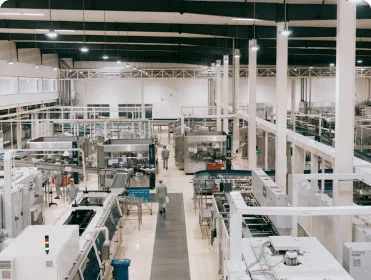AI-Powered Supply Chain Optimization: Revolutionizing Retail Logistics
Executive Summary
In the rapidly evolving landscape of global retail, supply chain efficiency stands as a critical differentiator between industry leaders and laggards. HawksCode, leveraging its extensive expertise in artificial intelligence and machine learning, undertook a groundbreaking project to revolutionize supply chain management for a major player in the retail sector. This case study delves deep into the intricacies of implementing a state-of-the-art, AI-driven supply chain optimization solution, showcasing HawksCode's ability to deliver transformative results in complex, enterprise-level environments.
Industry Context and Challenges

Demand Volatility:
Rapid shifts in consumer preferences, influenced by factors ranging from social media trends to global events, make traditional forecasting methods obsolete.
Inventory Complexity:
Managing inventory across thousands of SKUs, multiple warehouses, and various sales channels (brick-and-mortar, e-commerce, marketplaces) creates a multidimensional optimization problem.
Data Overload:
The sheer volume of data generated across the supply chain overwhelms traditional analysis methods, leading to missed opportunities and inefficiencies.
Sustainability Pressures:
Growing environmental concerns necessitate more sustainable supply chain practices, adding another layer of complexity to decision-making processes.
Global Disruptions:
Events like the COVID-19 pandemic, geopolitical tensions, and natural disasters highlight the need for resilient and adaptable supply chains.
Last-Mile Logistics:
The rise of same-day and next-day delivery expectations puts immense pressure on distribution networks
HawksCode's Innovative Approach
Recognizing the multifaceted nature of these challenges, HawksCode developed a comprehensive, AI-powered solution designed to transform every aspect of the supply chain. Our approach was built on several key pillars:
01
Holistic Data Integration
Challenge
Solution:
- Implemented a cloud-based data lake architecture using technologies like Apache Hadoop and Spark.
- Developed custom ETL pipelines to ingest, clean, and normalize data from disparate sources.
- Utilized stream processing technologies (e.g., Apache Kafka) to enable real-time data integration.
Technical Deep Dive:
- Employed Delta Lake to ensure ACID transactions in the data lake, crucial for maintaining data integrity in a high-volume environment.
- Implemented data quality checks using Great Expectations, ensuring consistency and reliability of incoming data.
- Utilized Databricks for collaborative data engineering and analytics, enabling seamless cooperation between data scientists and engineers.
02
Advanced Demand Forecasting
Challenge
Solution:
- Developed a multi-model ensemble forecasting system combining:
- LSTM (Long Short-Term Memory) neural networks for capturing long-term trends and seasonality.
- XGBoost for handling non-linear relationships and feature interactions.
- Prophet for incorporating domain-specific knowledge and handling holidays/events.
Technical Deep Dive:
- Implemented feature engineering pipelines to incorporate external data sources:
- Weather data (using APIs from weather services)
- Utilized Bayesian Optimization for hyperparameter tuning, ensuring optimal model performance..
- Implemented model explainability using SHAP (SHapley Additive exPlanations) values.
03
Inventory Optimization
Challenge
Solution:
- Developed a reinforcement learning model to dynamically optimize inventory levels:
- State: Current inventory levels, incoming shipments, forecasted demand
- Actions: Reorder quantities, transfer between locations
- Reward: Weighted combination of carrying costs, stockout penalties, and service level achievements
Technical Deep Dive:
- Utilized TensorFlow’s reinforcement learning library to implement a Deep Q-Network (DQN) algorithm.
- Developed a custom simulation environment using SimPy to train and evaluate the RL model under various scenarios.
- Implemented safety stock calculations using a novel approach that combines traditional methods (e.g., Gaver’s formula) with machine learning predictions of demand variability.
04
Intelligent Order Fulfillment
Challenge
Solution:
- Implemented a constrained optimization algorithm using mixed-integer linear programming (MILP):
- Objective: Minimize total fulfillment cost while meeting service level agreements
- Constraints: Inventory availability, shipping carrier capacities, promised delivery dates
Technical Deep Dive:
- Utilized Google’s OR-Tools for solving the MILP problem in real-time.
- Developed a custom heuristic algorithm for initial solution seeding, significantly reducing solve times for large-scale problems.
- Implemented a rolling horizon approach, re-optimizing allocation decisions every hour to account for new orders and changing conditions.
05
Predictive Maintenance and Risk Management
Challenge
Solution:
- Developed an IoT-based predictive maintenance system for critical warehouse equipment:
- Objective: Minimize total fulfillment cost while meeting Utilized sensor data (vibration, temperature, power consumption) to predict potential failures.service level agreements
- Created a supply chain risk assessment model:
- Incorporated geopolitical risk indicators, weather forecasts, and supplier financial health metrics.
Technical Deep Dive:
- Implemented edge computing using Azure IoT Edge to process sensor data in real-time, reducing latency and bandwidth usage.
- Utilized PySpark’s MLlib for distributed training of the Random Forest model, enabling scalability to handle data from thousands of equipment units.
- Implemented the Bayesian Network using the pgmpy library, allowing for intuitive modeling of complex dependencies in the supply chain risk landscape.
Implementation and Change Management
01
Phased Rollout
We analyze your business needs and data landscape to identify the best AI opportunities.
02
Continuous Training
I developed a training program with e-learning, workshops, and "train the trainer" sessions to enhance understanding .
03
KPI Alignment
Worked with stakeholders to align new AI-driven KPIs with existing business metrics, ensuring coherent performance measurement.
04
Feedback Loops
Established regular feedback sessions with end-users, incorporating their insights into iterative improvements of the system.
05
Executive Sponsorship
Secured and maintained strong executive sponsorship, crucial for driving organizational buy-in and overcoming resistance to change.
Results and Impact
1. Forecast Accuracy:
2. Inventory Optimization:
- 23% reduction in overall inventory levels
- 15% improvement in inventory turnover ratio
- 98% reduction in slow-moving and obsolete inventory write-offs
3. Order Fulfilment
- On-time, in-full (OTIF) delivery rates increased from 85% to 98%
- 12% reduction in average order fulfillment cost
- 25% increase in same-day delivery capability without additional infrastructure investment
4. Operational Efficiency:
- 15% reduction in overall logistics costs
- 30% improvement in warehouse labor productivity
- 40% reduction in manual planning and decision-making time
5. Financial Impact:
- $1.2 billion reduction in working capital requirements
- 7% increase in gross margins due to reduced markdowns and improved full-price sell-throug
- 18% reduction in total supply chain costs as a percentage of revenue
6. Customer Satisfaction:
- Net Promoter Score (NPS) improved by 20 points
- 35% reduction in customer complaints related to product availability and delivery issues
7. Sustainability:
- 18% reduction in carbon emissions from transportation optimization
- 25% decrease in food waste for perishable goods due to improved forecasting and inventory management
8. Agility and Resilience:
- 40% faster response time to major supply chain disruptions
- 60% improvement in accuracy of risk impact assessments
Lessons Learned and Best Practices
1. Data Quality is Paramount:
2. Cross-functional Collaboration is Key
3. Explainable AI Drives Adoption:
4. Continuous Learning and Adaptation:
5. Balance Automation with Human Expertise:
6. Scalability and Flexibility are Crucial:
7. Invest in Change Management:
8. Scalability and Flexibility are Crucial:
Conclusion
The successful implementation of HawksCode's AI-powered supply chain optimization solution demonstrates our ability to leverage cutting-edge technologies to solve complex, enterprise-level challenges. By combining deep industry knowledge with advanced technical expertise, we delivered a solution that not only addressed immediate pain points but also positioned our client at the forefront of supply chain innovation.

This case study showcases HawksCode's capabilities in:
- Large-scale data integration and management
- Advanced machine learning and AI model development
- Complex system integration in enterprise environments
- Change management and digital transformation
As the retail landscape continues to evolve, HawksCode remains committed to pushing the boundaries of what's possible in supply chain optimization. Our holistic approach, combining technological innovation with strategic business insights, enables us to deliver transformative solutions that drive tangible, long-lasting value for our clients.






